fuse Alfa Romeo 166 2006 Owner handbook (in English)
[x] Cancel search | Manufacturer: ALFA ROMEO, Model Year: 2006, Model line: 166, Model: Alfa Romeo 166 2006Pages: 272, PDF Size: 4.17 MB
Page 22 of 272
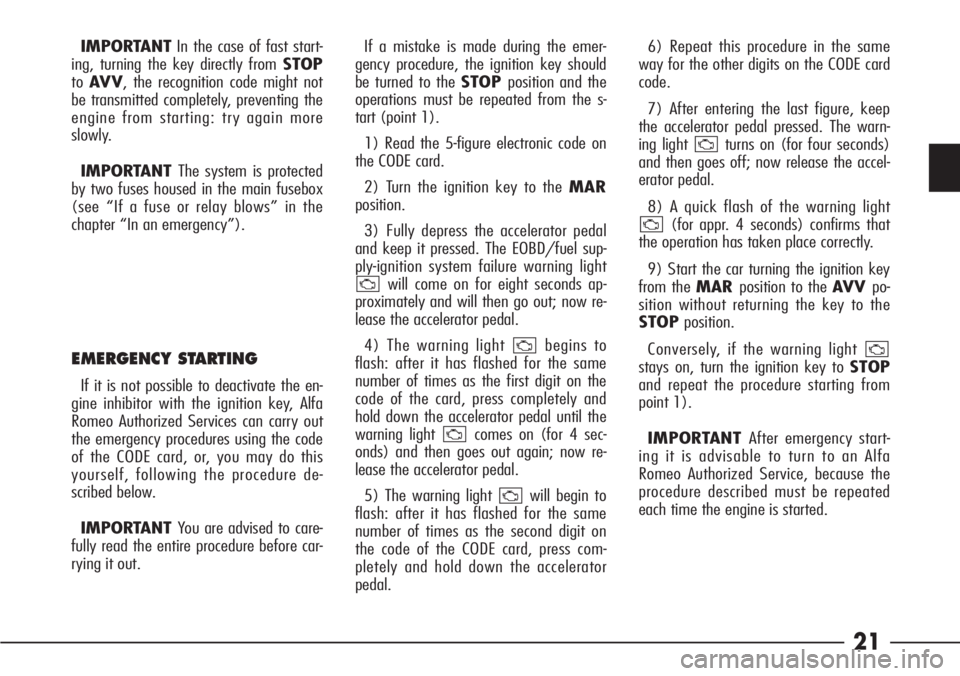
21
IMPORTANTIn the case of fast start-
ing, turning the key directly from STOP
toAV V, the recognition code might not
be transmitted completely, preventing the
engine from starting: try again more
slowly.
IMPORTANTThe system is protected
by two fuses housed in the main fusebox
(see “If a fuse or relay blows” in the
chapter “In an emergency”).
EMERGENCY STARTING
If it is not possible to deactivate the en-
gine inhibitor with the ignition key, Alfa
Romeo Authorized Services can carry out
the emergency procedures using the code
of the CODE card, or, you may do this
yourself, following the procedure de-
scribed below.
IMPORTANTYou are advised to care-
fully read the entire procedure before car-
rying it out.If a mistake is made during the emer-
gency procedure, the ignition key should
be turned to the STOPposition and the
operations must be repeated from the s-
tart (point 1).
1) Read the 5-figure electronic code on
the CODE card.
2) Turn the ignition key to the MAR
position.
3) Fully depress the accelerator pedal
and keep it pressed. The EOBD/fuel sup-
ply-ignition system failure warning light
will come on for eight seconds ap-
proximately and will then go out; now re-
lease the accelerator pedal.
4) The warning light begins to
flash: after it has flashed for the same
number of times as the first digit on the
code of the card, press completely and
hold down the accelerator pedal until the
warning light comes on (for 4 sec-
onds) and then goes out again; now re-
lease the accelerator pedal.
5) The warning light will begin to
flash: after it has flashed for the same
number of times as the second digit on
the code of the CODE card, press com-
pletely and hold down the accelerator
pedal.
U
U
U
U
6) Repeat this procedure in the same
way for the other digits on the CODE card
code.
7) After entering the last figure, keep
the accelerator pedal pressed. The warn-
ing light turns on (for four seconds)
and then goes off; now release the accel-
erator pedal.
8) A quick flash of the warning light
(for appr. 4 seconds) confirms that
the operation has taken place correctly.
9) Start the car turning the ignition key
from the MARposition to the AVV po-
sition without returning the key to the
STOPposition.
Conversely, if the warning light
stays on, turn the ignition key to STOP
and repeat the procedure starting from
point 1).
IMPORTANTAfter emergency start-
ing it is advisable to turn to an Alfa
Romeo Authorized Service, because the
procedure described must be repeated
each time the engine is started.
U
U
U
Page 31 of 272
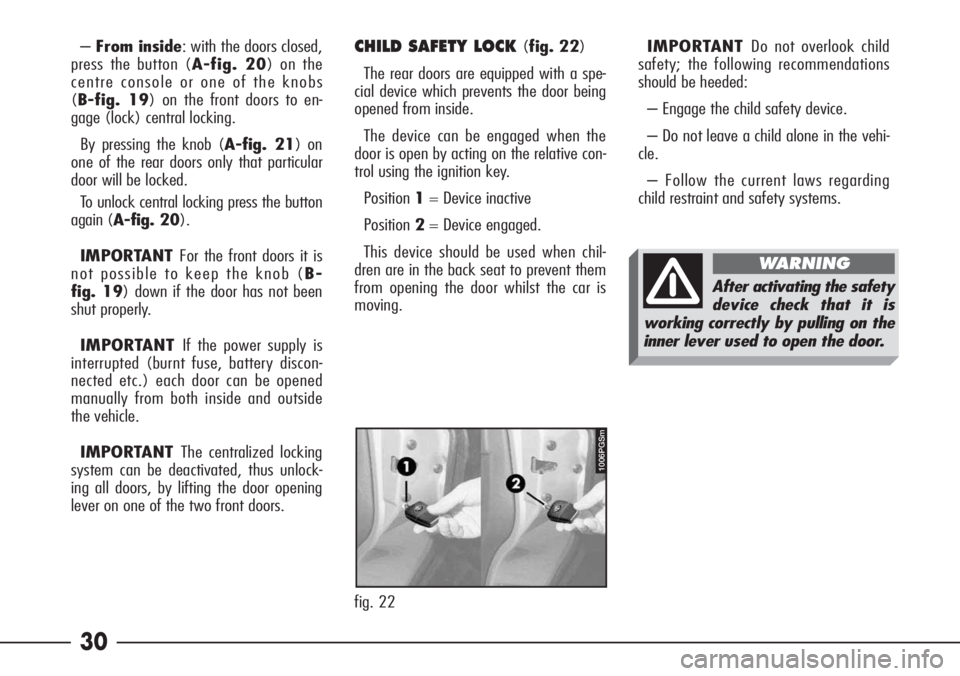
30
–From inside: with the doors closed,
press the button (A-fig. 20) on the
centre console or one of the knobs
(B-fig. 19) on the front doors to en-
gage (lock) central locking.
By pressing the knob (A-fig. 21) on
one of the rear doors only that particular
door will be locked.
To unlock central locking press the button
again (A-fig. 20).
IMPORTANT For the front doors it is
not possible to keep the knob (B-
fig. 19) down if the door has not been
shut properly.
IMPORTANT If the power supply is
interrupted (burnt fuse, battery discon-
nected etc.) each door can be opened
manually from both inside and outside
the vehicle.
IMPORTANT The centralized locking
system can be deactivated, thus unlock-
ing all doors, by lifting the door opening
lever on one of the two front doors.CHILD SAFETY LOCK (fig. 22)
The rear doors are equipped with a spe-
cial device which prevents the door being
opened from inside.
The device can be engaged when the
door is open by acting on the relative con-
trol using the ignition key.
Position1= Device inactive
Position2= Device engaged.
This device should be used when chil-
dren are in the back seat to prevent them
from opening the door whilst the car is
moving.IMPORTANT Do not overlook child
safety; the following recommendations
should be heeded:
– Engage the child safety device.
– Do not leave a child alone in the vehi-
cle.
– Follow the current laws regarding
child restraint and safety systems.
After activating the safety
device check that it is
working correctly by pulling on the
inner lever used to open the door.
WARNING
fig. 22
1006PGSm
Page 67 of 272
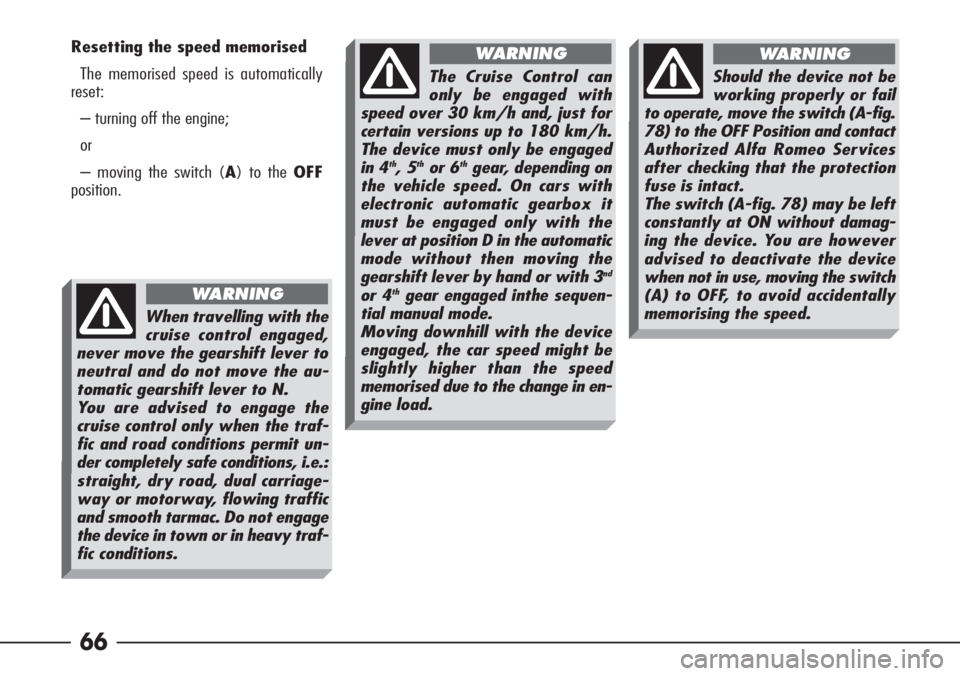
66
Resetting the speed memorised
The memorised speed is automatically
reset:
– turning off the engine;
or
– moving the switch (A) to the OFF
position.
When travelling with the
cruise control engaged,
never move the gearshift lever to
neutral and do not move the au-
tomatic gearshift lever to N.
You are advised to engage the
cruise control only when the traf-
fic and road conditions permit un-
der completely safe conditions, i.e.:
straight, dry road, dual carriage-
way or motorway, flowing traffic
and smooth tarmac. Do not engage
the device in town or in heavy traf-
fic conditions.
WARNING
The Cruise Control can
only be engaged with
speed over 30 km/h and, just for
certain versions up to 180 km/h.
The device must only be engaged
in 4
th, 5thor 6thgear, depending on
the vehicle speed. On cars with
electronic automatic gearbox it
must be engaged only with the
lever at position D in the automatic
mode without then moving the
gearshift lever by hand or with 3
nd
or 4thgear engaged inthe sequen-
tial manual mode.
Moving downhill with the device
engaged, the car speed might be
slightly higher than the speed
memorised due to the change in en-
gine load.
WARNING
Should the device not be
working properly or fail
to operate, move the switch (A-fig.
78) to the OFF Position and contact
Authorized Alfa Romeo Services
after checking that the protection
fuse is intact.
The switch (A-fig. 78) may be left
constantly at ON without damag-
ing the device. You are however
advised to deactivate the device
when not in use, moving the switch
(A) to OFF, to avoid accidentally
memorising the speed.
WARNING
Page 79 of 272
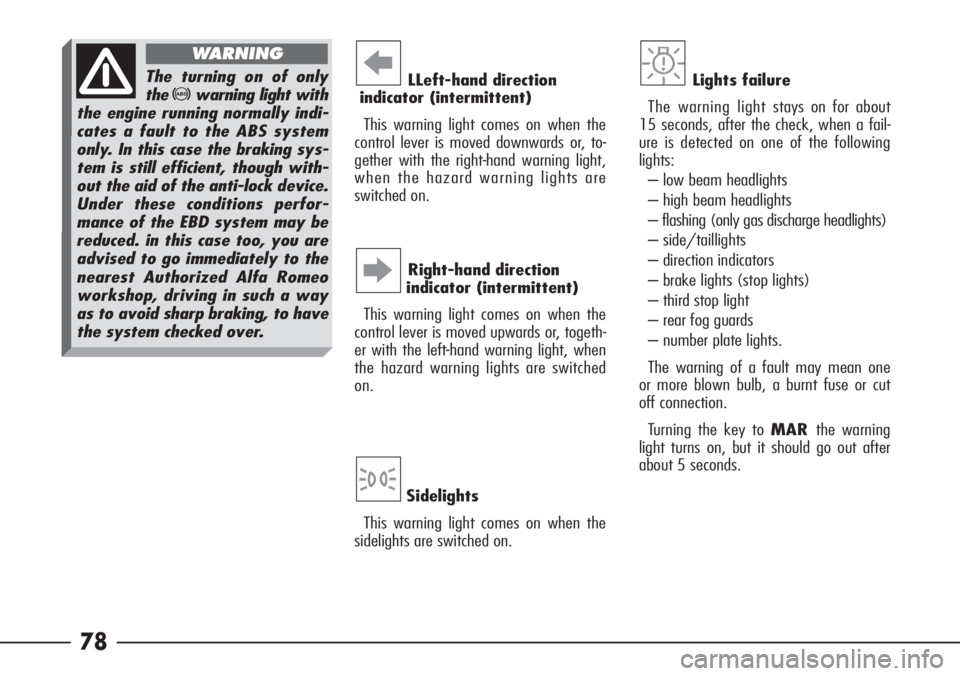
78
LLeft-hand direction
indicator (intermittent)
This warning light comes on when the
control lever is moved downwards or, to-
gether with the right-hand warning light,
when the hazard warning lights are
switched on. R
Sidelights
This warning light comes on when the
sidelights are switched on.3
Right-hand direction
indicator (intermittent)
This warning light comes on when the
control lever is moved upwards or, togeth-
er with the left-hand warning light, when
the hazard warning lights are switched
on.E
Lights failure
The warning light stays on for about
15 seconds, after the check, when a fail-
ure is detected on one of the following
lights:
– low beam headlights
– high beam headlights
– flashing (only gas discharge headlights)
– side/taillights
– direction indicators
– brake lights (stop lights)
– third stop light
– rear fog guards
– number plate lights.
The warning of a fault may mean one
or more blown bulb, a burnt fuse or cut
off connection.
Turning the key to MARthe warning
light turns on, but it should go out after
about 5 seconds.The turning on of only
the
>warning light with
the engine running normally indi-
cates a fault to the ABS system
only. In this case the braking sys-
tem is still efficient, though with-
out the aid of the anti-lock device.
Under these conditions perfor-
mance of the EBD system may be
reduced. in this case too, you are
advised to go immediately to the
nearest Authorized Alfa Romeo
workshop, driving in such a way
as to avoid sharp braking, to have
the system checked over.
WARNING
Page 158 of 272

157
The following pages give indications necessary in the event of an
emergency.
The subjects dealt with take into account numerous minor prob-
lems which the driver may have to face and indicate the type of
intervention to be carried out. Contact Alfa Romeo Authorized Ser-
vices for the more serious problems.
The following pages should therefore, be read through carefully
so that, if an emergency arises, you know where to search for the
relevant information.IN THE EVENT OF A PUNCTURE .............................................................page 158
IF ONE OF THE EXTERNAL LIGHTS GOES OUT
............................................165
IF ONE OF THE INTERNAL LIGHTS GOES OUT
.............................................181
IN THE EVENT OF A BURNT FUSE OR RELAY
...............................................186
IN THE EVENT OF A FLAT BATTERY
..................................................................194
IF THE VEHICLE OR ANOTHER VEHICLE IS TO BE TOWED
.......................196
IF THE VEHICLE IS TO BE LIFTED
.....................................................................197
IN THE EVENT OF AN ACCIDENT
......................................................................198
IN AN EMERGENCY
Page 166 of 272
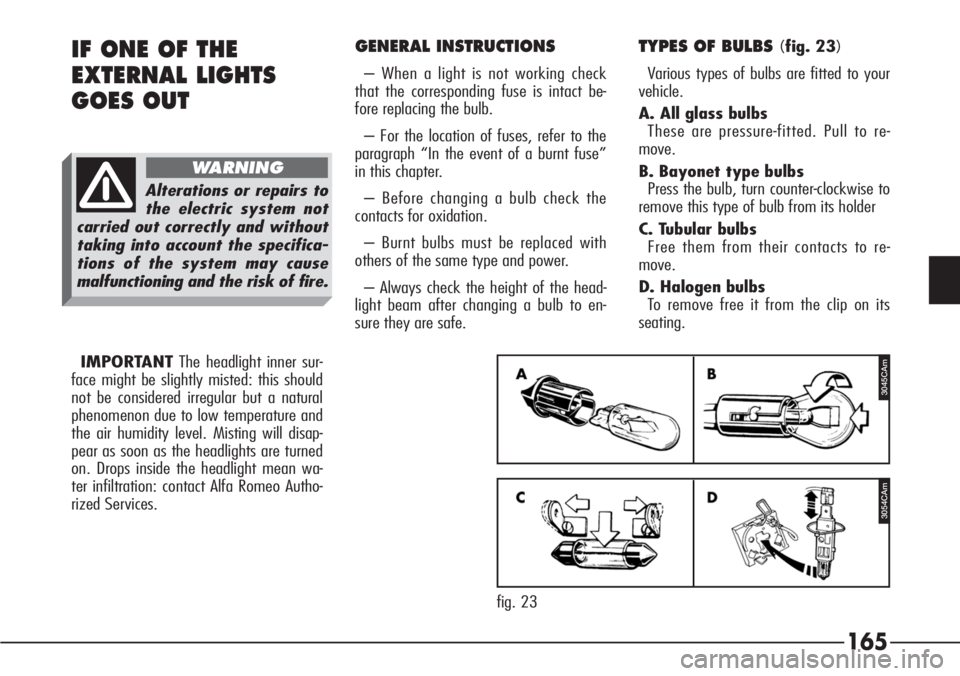
165
GENERAL INSTRUCTIONS
– When a light is not working check
that the corresponding fuse is intact be-
fore replacing the bulb.
– For the location of fuses, refer to the
paragraph “In the event of a burnt fuse”
in this chapter.
– Before changing a bulb check the
contacts for oxidation.
– Burnt bulbs must be replaced with
others of the same type and power.
– Always check the height of the head-
light beam after changing a bulb to en-
sure they are safe.
TYPES OF BULBS (fig. 23)
Various types of bulbs are fitted to your
vehicle.
A. All glass bulbs
These are pressure-fitted. Pull to re-
move.
B. Bayonet type bulbs
Press the bulb, turn counter-clockwise to
remove this type of bulb from its holder
C. Tubular bulbs
Free them from their contacts to re-
move.
D. Halogen bulbs
To remove free it from the clip on its
seating.IF ONE OF THE
EXTERNAL LIGHTS
GOES OUT
Alterations or repairs to
the electric system not
carried out correctly and without
taking into account the specifica-
tions of the system may cause
malfunctioning and the risk of fire.
WARNING
3045CAm
3054CAm
fig. 23 IMPORTANTThe headlight inner sur-
face might be slightly misted: this should
not be considered irregular but a natural
phenomenon due to low temperature and
the air humidity level. Misting will disap-
pear as soon as the headlights are turned
on. Drops inside the headlight mean wa-
ter infiltration: contact Alfa Romeo Autho-
rized Services.
Page 187 of 272
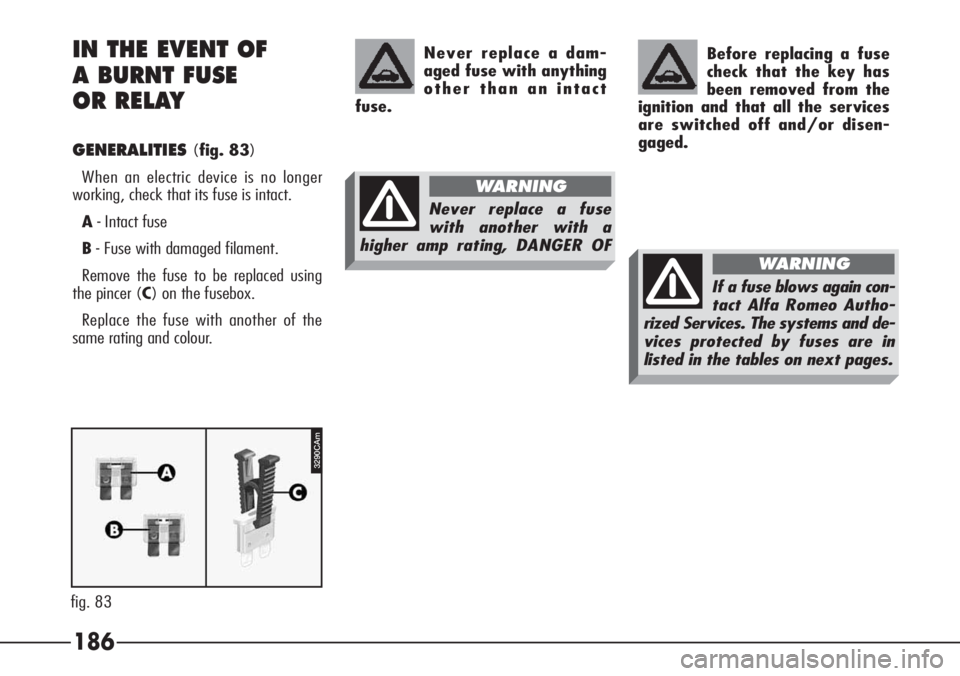
186 IN THE EVENT OF
A BURNT FUSE
OR RELAY
GENERALITIES(fig. 83)
When an electric device is no longer
working, check that its fuse is intact.
A- Intact fuse
B- Fuse with damaged filament.
Remove the fuse to be replaced using
the pincer (C) on the fusebox.
Replace the fuse with another of the
same rating and colour.Before replacing a fuse
check that the key has
been removed from the
ignition and that all the services
are switched off and/or disen-
gaged.
Never replace a dam-
aged fuse with anything
other than an intact
fuse.
Never replace a fuse
with another with a
higher amp rating, DANGER OF
WARNING
3290CAm
fig. 83
If a fuse blows again con-
tact Alfa Romeo Autho-
rized Services. The systems and de-
vices protected by fuses are in
listed in the tables on next pages.
WARNING
Page 188 of 272

187
FUSES AND RELAYS IN THE
CONTROL UNIT
The fuses for the main devices are
housed in a control unit under the dash-
board, to the left of the steering column.
Access to it is gained slackening the
knob (A-fig. 84) and lowering the pan-
el (B).
The graphic symbols which distinguish
the main electric component correspond-
ing to each fuse are given on a label on
the inner wall of the panel.In the upper part of the control unit
there is a pincer (C-fig. 85) for remov-
ing fuses.
At the sides of the control unit there are
some spare fuses (C-fig. 86); after re-
placing a fuse you are advised to replen-
ish the stock of fuses when they are
used.
The systems and devices protected by
fuses are in listed in the tables on next
pages.The circuits operated by relays are the
following (fig. 86):
A- Switch discharge relay
B- Headlight washer timer.
511bPGSm
fig. 85
511aPGSm
fig. 84
A0D0145m
fig. 86
Page 189 of 272
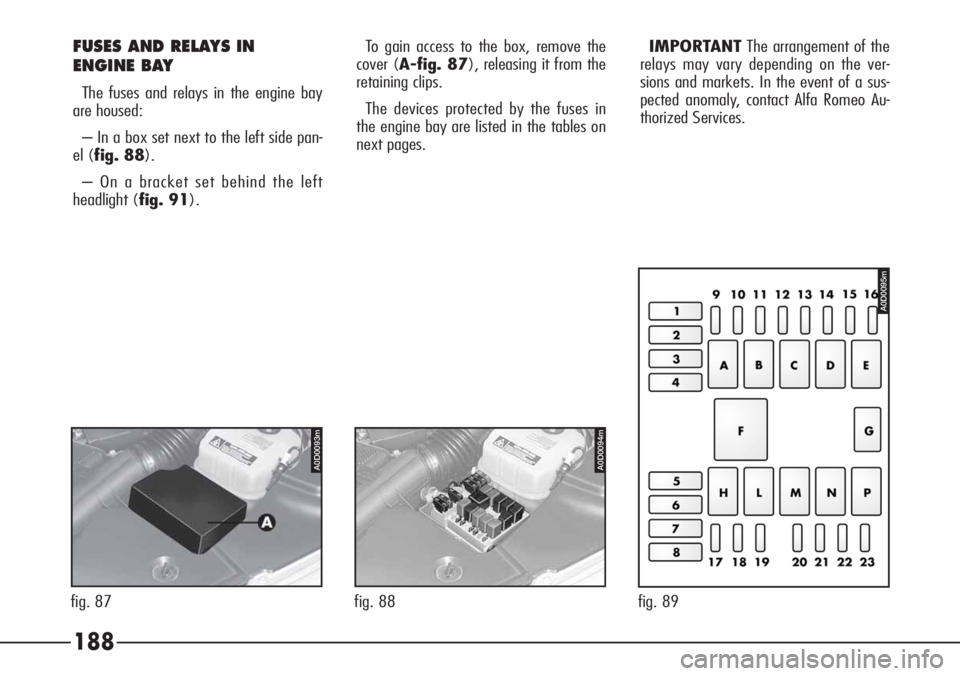
188
FUSES AND RELAYS IN
ENGINE BAY
The fuses and relays in the engine bay
are housed:
– In a box set next to the left side pan-
el (fig. 88).
– On a bracket set behind the left
headlight (fig. 91).To gain access to the box, remove the
cover (A-fig. 87), releasing it from the
retaining clips.
The devices protected by the fuses in
the engine bay are listed in the tables on
next pages.IMPORTANTThe arrangement of the
relays may vary depending on the ver-
sions and markets. In the event of a sus-
pected anomaly, contact Alfa Romeo Au-
thorized Services.
A0D0093m
fig. 87
A0D0094m
fig. 88 fig. 89
A0D0095m
Page 191 of 272
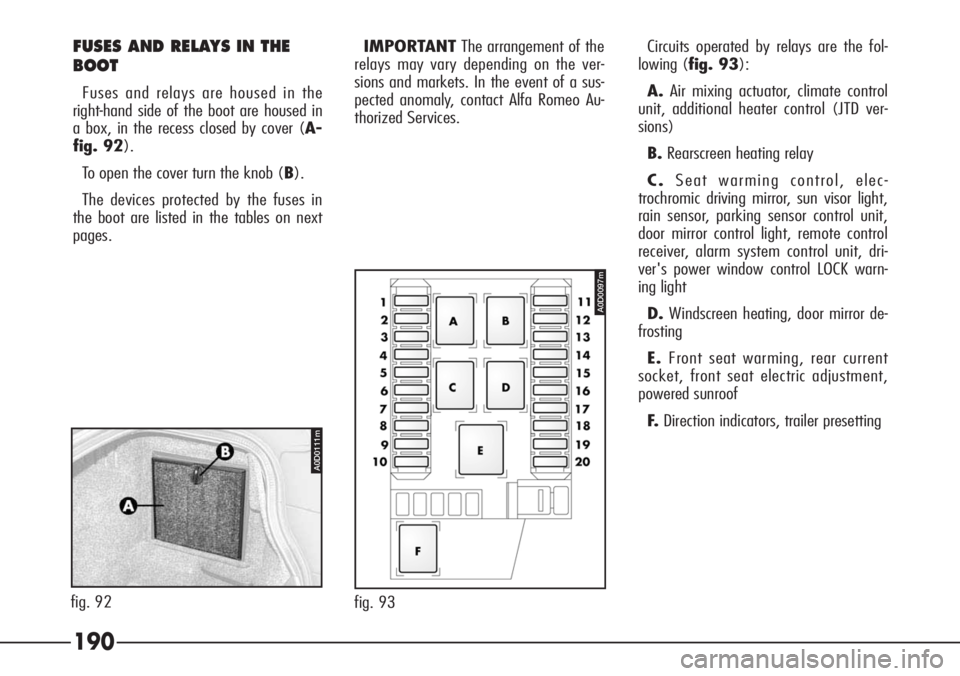
190
FUSES AND RELAYS IN THE
BOOT
Fuses and relays are housed in the
right-hand side of the boot are housed in
a box, in the recess closed by cover (A-
fig. 92).
To open the cover turn the knob (B).
The devices protected by the fuses in
the boot are listed in the tables on next
pages.IMPORTANTThe arrangement of the
relays may vary depending on the ver-
sions and markets. In the event of a sus-
pected anomaly, contact Alfa Romeo Au-
thorized Services.Circuits operated by relays are the fol-
lowing (fig. 93):
A.Air mixing actuator, climate control
unit, additional heater control (JTD ver-
sions)
B.Rearscreen heating relay
C.Seat warming control, elec-
trochromic driving mirror, sun visor light,
rain sensor, parking sensor control unit,
door mirror control light, remote control
receiver, alarm system control unit, dri-
ver's power window control LOCK warn-
ing light
D.Windscreen heating, door mirror de-
frosting
E.Front seat warming, rear current
socket, front seat electric adjustment,
powered sunroof
F.Direction indicators, trailer presetting
518PGS
fig. 93
A0D0097m
A0D0111m
fig. 92